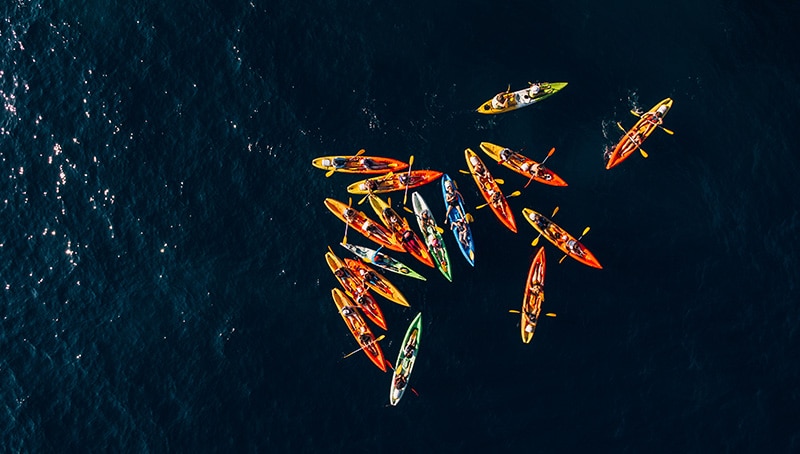Florida is known for its water sports more than almost any other recreational activity.
The state is home to more than 1,000 miles of coastline.
It’s the perfect place for beach lovers, boaters, and kayakers alike.
Before taking your kayak out on the water, it’s important to understand the laws for owning and operating a kayak.
We’ve compiled all the rules and regulations for kayaking safely while enjoying the beautiful water in Florida.
Kayaking Registration Laws
Luckily, non-motorized kayaks are not required to have registration in Florida.
You don’t need to register a non-motorized kayak regardless of the length.
However, you do need registration for motorized vehicles.
Motorized Vessels
All vehicles that are motor-powered in Florida must have a title and registration.
Motorized boats, kayaks, canoes, and other water vessels all require registration.
You can register your motor-powered vehicle at the tax office in your local county.
You must get your registration within 30 days of purchasing a water vessel in Florida.
Once your water vessel is registered, you have to display the registration on the front while it’s being operated.
The registration should also be visible on both sides of the vehicle, above the waterline.
The cost of registration varies from boat to boat.
The longer your vessel is, the more expensive it will be to register.
Licenses
In most cases, you do need a license to operate a motorized kayak in Florida.
Anyone born on or after January 1, 1988, who wants to operate a motorized water vessel must acquire a license.
You can receive a license after completing a National Association of State Boating Law Administrators (NASBLA) education class or the equivalent.
You can find a Florida Boating Education course on Boat-ed.com.
The good news is, you don’t need a boating license if you’re operating a non-motorized kayak.

Kayaking Alcohol and Drug Laws
It’s advisable not to consume alcohol or drugs while operating a kayak.
Operating a kayak in Florida under the influence warrants the same consequences as driving under the influence.
Boating Under the Influence (BUI) and Driving Under the Influence (DUI) are essentially the same thing in Florida.
If your blood alcohol level meets or exceeds .08%, you’re considered intoxicated.
If you’re under 21, the level you’re considered intoxicated at is .02%.
Operating a water vessel while drinking or doing drugs is a violation of Florida law.
Fines
The first offense after getting a BUI ranges from $500 to $1,000 and up to six months in prison.
The second offense ranges from $1,000 to $2,000 and up to nine months in prison.
After the third offense, the penalties continue to get worse.
Warrants
The United States Coast Guard has the authority to board your vessel at any time.
Additionally, Florida Fish and Wildlife Commission Officers can board your vessel if they suspect alcohol or drug use while aboard.
They also can carry out a safety inspection at any moment.
Kayaking Lights
You are required to have lights on your kayak during periods of low visibility.
Recreational Vehicles
At night between sunset and sunrise, during fog, rain, and any kind of precipitation, lights must be handy on your vessel.
You do not need to turn the lights on unless another vehicle is approaching.
Some lights that would work well include, red and green bow lights, white lights, or a flashlight.
If you are not currently operating your kayak, but it is anchored, you must have a white light that can be seen from every direction.
Life Jackets
It may seem obvious, but Florida law requires that there is one personal floatation device (PFD) for each person on board a vessel at a time.
The jackets must be US Coast Guard Approved.
They all must be the proper size for the wearer, be easily reachable, and be in good condition.
Adults are not mandated to wear life jackets at all times.
However, children under 6 are required to wear a life jacket that is a Type I, Type II, or Type III USCG-approved PFD.
If your kayak exceeds 16 feet, there has to be an immediately accessible throwable Type IV PFD.
Fire Extinguishers
You most likely don’t need a fire extinguisher to operate a kayak in Florida.
The only time you’ll need one is if your kayak is more than 26 feet long.
In the case of a big boat, you’re required to have a USCG-approved B-1 fire extinguisher onboard.
You shouldn’t worry about having a fire extinguisher on your kayak if it’s not motorized.
Kayaking Distress Signals
It is important to have signals available onboard your kayak in case of an emergency.
Sounding Devices
Florida Kayakers need to have a sound-making device on them while operating their vessel.
Most kayakers opt for whistles, and they must be able to be heard at least one-half nautical mile away.
Visual Distress Signals (VDS)
Vehicles less than 16 feet in length must carry at least three visual distress signals at night.
Red flares and electric distress lights are effective options.
If you choose to use an electric distress light, it’s required to meet the USCG requirement of 46 Code of Federal Regulations 161.013.
The electric light has to be automatic and reflect the SOS distress signal.
Vessels that are longer than 16 feet are required to have at least three VDSs for both the nighttime and daytime on board 24/7 while on coastal waters.
Conclusion
Now that you are aware of Florida’s Kayaking laws, you should be ready to take yours out on the water.
It is important to note that there is no age limit to operating a kayak unless it’s motorized.
Some of the most important components to remember are that you must have life jackets, a whistle, and lights on your water vessel.
After including these main things, you should be ready to enjoy all the warm waters Florida has to offer.
